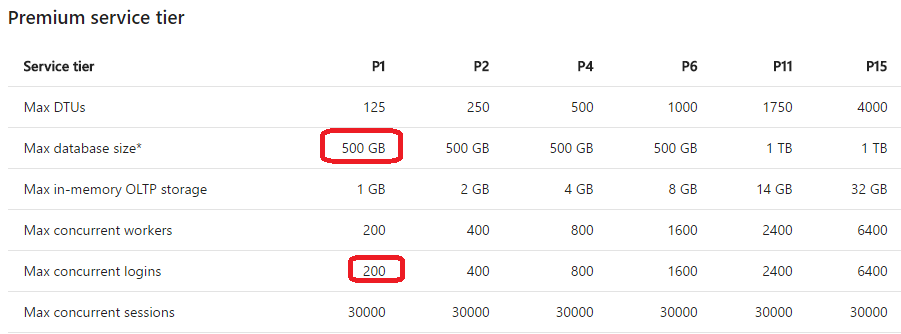File Info
| Exam | Provisioning SQL Databases |
| Number | 70-765 |
| File Name | Microsoft.70-765.ActualTests.2018-12-01.98q.tqb |
| Size | 2 MB |
| Posted | Dec 01, 2018 |
| Download | Microsoft.70-765.ActualTests.2018-12-01.98q.tqb |
How to open VCEX & EXAM Files?
Files with VCEX & EXAM extensions can be opened by ProfExam Simulator.
Coupon: MASTEREXAM
With discount: 20%





Demo Questions
Question 1

You plan to migrate a database to Microsoft Azure SQL Database. The database requires 500 gigabytes (GB) of storage.
The database must support 50 concurrent logins. You must minimize the cost associated with hosting the database.
You need to create the database.
Which pricing tier should you use?
- Standard S3 pricing tier
- Premium P2 tier
- Standard S2 pricing tier
- Premium P1 tier
Correct answer: D
Explanation:
For a database size of 500 GB the Premium tier is required. Both P1 and P2 are adequate. P1 is preferred as it is cheaper. Note: Incorrect Answers:A, C: Maximum database size is 250 GB for the Standard pricing tier.References: https://docs.microsoft.com/en-us/azure/sql-database/sql-database-service-tiers For a database size of 500 GB the Premium tier is required.
Both P1 and P2 are adequate. P1 is preferred as it is cheaper.
Note:

Incorrect Answers:
A, C: Maximum database size is 250 GB for the Standard pricing tier.
References: https://docs.microsoft.com/en-us/azure/sql-database/sql-database-service-tiers
Question 2
You plan to deploy 20 Microsoft Azure SQL Database instances to an elastic pool in Azure to support a batch processing application.
Two of the databases in the pool reach their peak workload threshold at the same time every day. This leads to inconsistent performance for batch completion.
You need to ensure that all batches perform consistently.
What should you do?
- Create an In-Memory table.
- Increase the storage limit in the pool.
- Implement a readable secondary database.
- Increase the total number of elastic Database Transaction Units (eDTUs) in the pool.
Correct answer: D
Explanation:
In SQL Database, the relative measure of a database's ability to handle resource demands is expressed in Database Transaction Units (DTUs) for single databases and elastic DTUs (eDTUs) for databases in an elastic pool. A pool is given a set number of eDTUs, for a set price. Within the pool, individual databases are given the flexibility to auto-scale within set parameters. Under heavy load, a database can consume more eDTUs to meet demand. Additional eDTUs can be added to an existing pool with no database downtime. References: https://docs.microsoft.com/en-us/azure/sql-database/sql-database-elastic-pool In SQL Database, the relative measure of a database's ability to handle resource demands is expressed in Database Transaction Units (DTUs) for single databases and elastic DTUs (eDTUs) for databases in an elastic pool.
A pool is given a set number of eDTUs, for a set price. Within the pool, individual databases are given the flexibility to auto-scale within set parameters. Under heavy load, a database can consume more eDTUs to meet demand.
Additional eDTUs can be added to an existing pool with no database downtime.
References: https://docs.microsoft.com/en-us/azure/sql-database/sql-database-elastic-pool
Question 3
A company has an on-premises Microsoft SQL Server 2014 environment. The company has a main office in Seattle, and remote offices in Amsterdam and Tokyo.
You plan to deploy a Microsoft Azure SQL Database instance to support a new application. You expect to have 100 users from each office.
In the past, users at remote sites reported issues when they used applications hosted at the Seattle office.
You need to optimize performance for users running reports while minimizing costs.
What should you do?
- Implement an elastic pool.
- Implement a standard database with readable secondaries in Asia and Europe, and then migrate the application.
- Implement replication from an on-premises SQL Server database to the Azure SQL Database instance.
- Deploy a database from the Premium service tier.
Correct answer: B
Explanation:
References: https://docs.microsoft.com/en-us/azure/sql-database/sql-database-geo-replication-transact-sql#add-secondary-database References: https://docs.microsoft.com/en-us/azure/sql-database/sql-database-geo-replication-transact-sql#add-secondary-database

